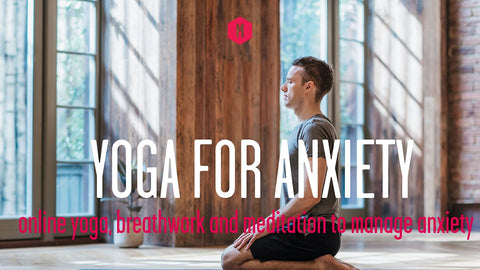To understand more about what it is, and why we should give it particular attention in menopause, we sat down with the wonderful team at Movement For Modern Life. And this is what we learned.
Context:
We are hearing more and more about this magic nerve that plays such a fundamental role in our nervous system, the Vagus Nerve. But what exactly is this nerve, where can we find it, and how can we use it to support us through menopause?!
The Vagus nerve has been called by some the ‘secret weapon in fighting stress’
The vagus nerve acts as a “super information highway” communicating between the brain and our body’s systems regulating our mood, digestion, heart rate and hormones. The vagus nerve balances our nervous system by switching on our parasympathetic 'rest and digest' mode and influences how we connect and feel safe with others.
Are we chronically stressed?
Stress is another buzz word we hear going round all the time these days. SO many of us are chronically stressed, overwhelmed and feeling anxious. As James Nestor puts it ‘we walk through the day half asleep and go through the night half awake’. A chronic low level stress is plaguing a generation. Stress affects our physical and mental health so it must be a priority to find ways to manage and lower our stress levels. Read Yoga for Stress & Anxiety for ways yoga can be supportive through more challenging moments.
There are many techniques we can use to manage stress, reduce pain, improve sleep and regulate our nervous systems so we train our system to have a less intense response to stress triggers.

Try The Yoga for Anxiety Course on Movement for Modern Life for more resources to deal with stress and anxiety.
What happens when we are triggered, or experience high stress, is that our body prepares to protect itself. Some people fight, some freeze and some run away from the situation, all in an attempt to keep ourselves safe. This is a learnt response from a young age, mostly in our earliest years of life, and generally would have been about survival. This is known as the ‘fight or flight’ response. Luckily these days we are not necessarily fighting for our survival but our nervous system can still respond to triggers in a similar fashion nonetheless.
What tends to happen when we are chronically stressed, is we stay in survival mode, with all the stress hormones running through our body. Imagine how exhausting this is for our poor bodies! Over time we can develop a multitude of health problems including chronic pain, anxiety, inflammation in various parts of the body, hormonal imbalances and so much more.
The hormonal changes we go through as we hit menopause can also cause a spike in our cortisol and adrenaline as other hormone levels decrease. This can also cause the nervous system and stress response to be out of balance. This results in one of the main symptoms of menopause being mental health and anxiety related issues. Learning ways to calm the nervous system and activate the Vagus Nerve is vital for surviving menopause too. Read more about Yoga for Menopause in this Complete Guide.
Whilst this all sounds bleak, the good news is that our own bodies hold the magic key and super power to regulate our response to stress and help us feel safe - the Vagus Nerve!
Where is the vagus nerve?
The vagus nerve is a cranial nerve that connects the brain to the body. It is the main nerve of the nervous system, and runs from the brain down through the face, neck, sternum, down past the diaphragm to the stomach.
Activating this pathway of the vagus can counterbalance stress responses in the body. Instead of stimulating stress, it triggers a relaxation response. Stimulating the vagus nerve can have profoundly beneficial results for our health, minds, bodies, relationships, sleep… the list goes on!
How to stimulate the vagus nerve?
The vagus nerve acts much like a muscle in the body, it needs to be trained, and the more we use it the more effectively it functions when we need it.
Ways to train our vagus nerve can include breathing practices, tracing of the vagus nerve pathway, practices of titration, somatic soft movement, and using sound and vibration.
The breath is an easy tool to come back to, taking time to focus on the breath not only activates the diaphragm (which is part of the pathway of the vagus nerve) but it focuses the mind on the rhythm of the breath, rather than the trigger or fear. When we focus on the breath it takes the attention away from that stressor and it immediately reduces the impact the stressor is having on our nervous system.
When our nervous system is activated and in survival mode, we are likely to be holding our breath. This is a natural response to fear and stress as it puts us in a more active, awake state to make fast decisions about whether to run, fight, and essentially how to survive. Short and shallow breath can increase pain, tightness and of course anxiety in our body. Slow deepening of the breath is a way to counter this stressed response and calm anxiety. Try and train the breath by setting an alarm three times a day to stop, to take 5 minutes to breathe slow, to send the breath into the belly and expand the rib cage. Then lengthen the exhale and trigger relaxation and softening of the body.
3 ways to calm the nervous system and activate the vagus nerve:
-
Yoga to take us into rest and digest mode https://movementformodernlife.com/yoga-class-1514-yoga-to-rest-digest-the-vagus-nerve
Try this class with Gabriella to learn simple practices to reset the nervous system using breath, sound, gentle movement and massage. These are techniques that stimulate the vagus nerve and encourage deep relaxation. The techniques can be done as part of this class or as stand alone practices to come back to throughout the day whenever we need them.
-
Breath Work
As mentioned above, when our nervous system is triggered it is likely to effect our breath. Our breath mimics how we are feeling, if we are sad there is pain in the chest, if we are scared we gasp for air! This 10 day challenge with Dan Peppiatt is a discovery into different breathing techniques. The key is that we can learn simple techniques to ‘trick’ our body into feeling calmer, more relaxed or more energised, by simply learning how to change our breath. https://movementformodernlife.com/challenge-breath-challenge
-
Sound Healing vibrations
https://movementformodernlife.com/challenge-sound-healing-journey
Sound healing is the therapeutic application of soundwaves (frequency) with the intention of bringing us into balance and harmony. Sound vibrations enhance the relaxation response of the nervous system and change our brain wave state to take us into deep rest. Sound works on different levels including the mental, emotional, spiritual, and physical levels.
Learn more about the vagus nerve, menopause, and how to use yoga, breath work and mindfulness to support you through the menopause at any stage, in the Menopause for Modern Life course.
Written by Joanna Gilbert on behalf of Movement for Modern Life.
Share Twitter Facebook Pinterest

